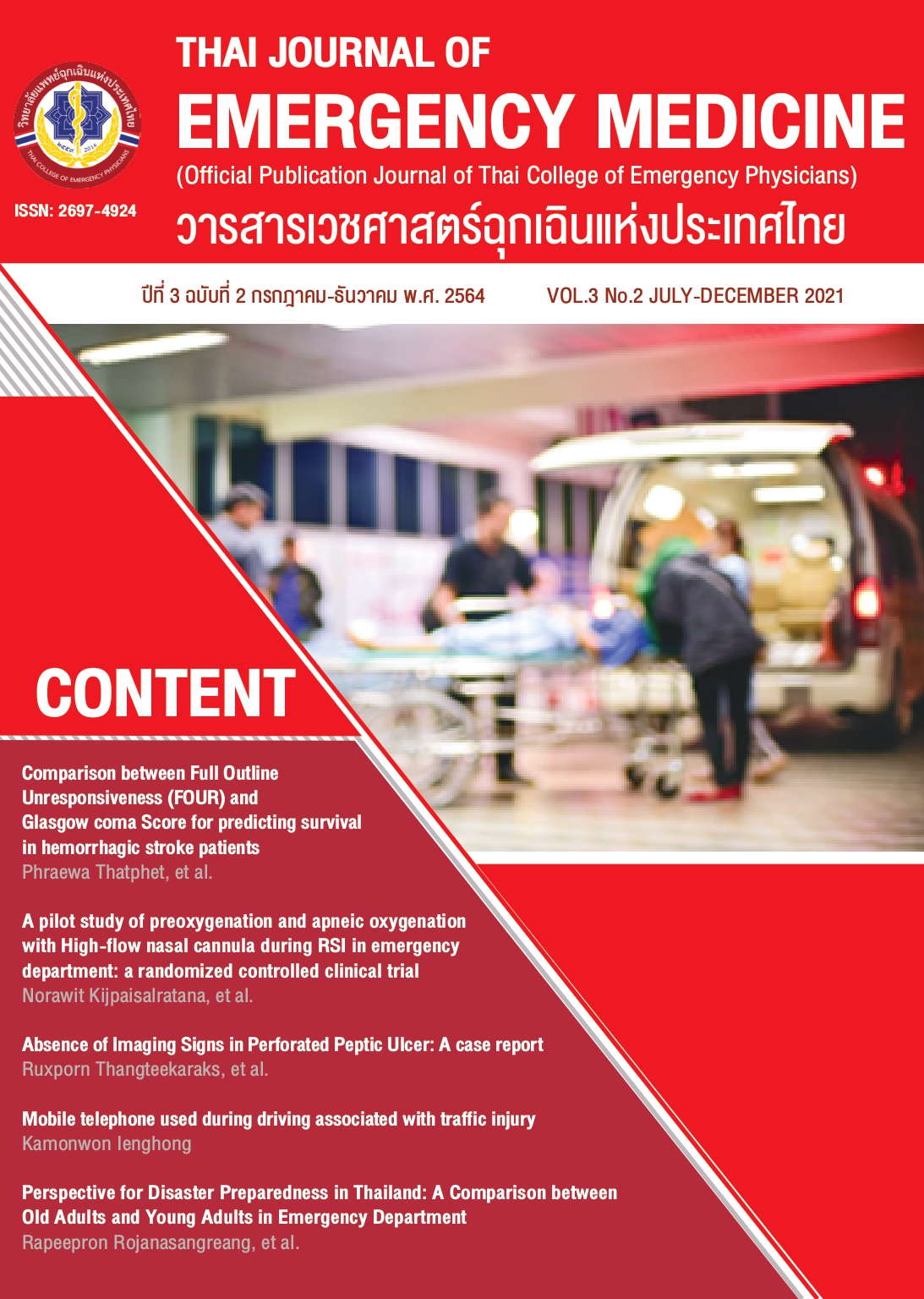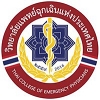A pilot study of preoxygenation and apneic oxygenation with High-flow nasal cannula during RSI in emergency department : a randomized controlled clinical trial
Keywords:
Rapid sequence intubation, apneic oxygenation, high flow nasal cannula, desaturationAbstract
Introduction : Desaturation is one of the most common complications during rapid sequence intubation(RSI). High flow nasal cannula has been widely studied especially in intensive care unit settings to prevent desaturation during intubation. However, the effectiveness of the treatment remains inconclusive. This is the first randomized controlled study focusing on high flow nasal cannula in patients with hypoxic respiratory failure emergency department setting.
Method : This single-centered randomized controlled trial was conducted at the emergency department of King Chulalongkorn Memorial Hospital which is an urban university hospital. Acute hypoxic respiratory failure adults requiring intubation were randomly allocated to 1) standard care by RSI without apneic oxygenation, 2) preoxygenation by non-rebreathing mask with bag or bag valve mask and apneic oxygenation with nasal cannula 15LPM, and 3) preoxygenation and apneic oxygenation with 60 LPM high flow nasal cannula. Oxygenation in each patient was monitored by pulse oximetry during RSI.
Objective : The primary outcome of this study was the incidence of desaturation during intubation.
Result : A total of 27 patients were enrolled in this pilot study. There was no incidence of desaturation in the high flow nasal cannula group. Incidence of desaturation was demonstrated in the standard care group and nasal cannula 15 LPM group (22.2% and 28.6% respectively). However, there was no statistically significant in the proportion of desaturation patients among all study groups (28.6% standard care vs 22.2% nasal cannula 15 LPM, p=0.771; 0% high flow nasal cannula vs 22.2% nasal cannula 15 LPM, p=0.099; 0% high flow nasal cannula vs 28.6% nasal cannula, p=0.06 )
Conclusion :This study demonstrated that using a high flow nasal cannula for preoxygenation and apneic oxygenation during RSI showed no statistical significance in the incidence of desaturation comparing to the standard of care.
References
Gebremedhn EG, Mesele D, Aemero D, Alemu E. The incidence of oxygen desaturation during rapid sequence induction and intubation. World J Emerg Med 2014;5:279-85.
Griesdale DE, Bosma TL, Kurth T, Isac G, Chittock DR. Complications of endotracheal intubation in the critically ill. Intensive Care Med 2008;34:1835-42.
Jaber S, Amraoui J, Lefrant JY, Arich C, Cohendy R, Landreau L, et al. Clinical practice and risk factors for immediate complications of endotracheal intubation in the intensive care unit: a prospective, multiple-center study. Crit Care Med 2006;34:2355-61.
Sakles JC, Chiu S, Mosier J, Walker C, Stolz U. The importance of first pass success when performing orotracheal intubation in the emergency department. Acad Emerg Med 2013;20:71-8.
Hypes C, Sakles J, Joshi R, Greenberg J, Natt B, Malo J, et al. Failure to achieve first attempt success at intubation using video laryngoscopy is associated with increased complications. Intern Emerg Med 2016.
Simpson GD, Ross MJ, McKeown DW, Ray DC. Tracheal intubation in the critically ill: a multi-centre national study of practice and complications. Br J Anaesth 2012;108:792-9.
Marsch SC, Steiner L, Bucher E, Pargger H, Schumann M, Aebi T, et al. Succinylcholine versus rocuronium for rapid sequence intubation in intensive care: a prospective, randomized controlled trial. Crit Care 2011;15:R199.
Taha SK, El-Khatib MF, Baraka AS, Haidar YA, Abdallah FW, Zbeidy RA, et al. Effect of suxamethonium vs rocuronium on onset of oxygen desaturation during apnoea following rapid sequence induction. Anaesthesia 2010;65:358-61.
Tang L, Li S, Huang S, Ma H, Wang Z. Desaturation following rapid sequence induction using succinylcholine vs. rocuronium in overweight patients. Acta Anaesthesiol Scand 2011;55:203-8.
Nishimura M. High-flow nasal cannula oxygen therapy in adults. J Intensive Care 2015;3:15.
Roca O, Hernandez G, Diaz-Lobato S, Carratala JM, Gutierrez RM, Masclans JR. Current evidence for the effectiveness of heated and humidified high flow nasal cannula supportive therapy in adult patients with respiratory failure. Crit Care 2016;20:109.
Riyapan S, Lubin J. Apneic Oxygenation May Not Prevent Severe Hypoxemia During Rapid Sequence Intubation: A Retrospective Helicopter Emergency Medical Service Study. Air Med J 2016;35:365-8.
Wimalasena Y, Burns B, Reid C, Ware S, Habig K. Apneic oxygenation was associated with decreased desaturation rates during rapid sequence intubation by an Australian helicopter emergency medicine service. Ann Emerg Med 2015;65:371-6.
Sakles JC, Mosier JM, Patanwala AE, Arcaris B, Dicken JM. First Pass Success Without Hypoxemia Is Increased With the Use of Apneic Oxygenation During Rapid Sequence Intubation in the Emergency Department. Acad Emerg Med 2016;23:703-10.
Sakles JC, Mosier JM, Patanwala AE, Dicken JM. Apneic oxygenation is associated with a reduction in the incidence of hypoxemia during the RSI of patients with intracranial hemorrhage in the emergency department. Intern Emerg Med 2016;11:983-92.
Semler MW, Janz DR, Lentz RJ, Matthews DT, Norman BC, Assad TR, et al. Randomized Trial of Apneic Oxygenation during Endotracheal Intubation of the Critically Ill. Am J Respir Crit Care Med 2016;193:273-80.
Kim TH, Hwang SO, Cha YS, Kim OH, Lee KH, Kim H, et al. The utility of noninvasive nasal positive pressure ventilators for optimizing oxygenation during rapid sequence intubation. Am J Emerg Med 2016;34:1627-30.
Vourc'h M, Asfar P, Volteau C, Bachoumas K, Clavieras N, Egreteau PY, et al. High-flow nasal cannula oxygen during endotracheal intubation in hypoxemic patients: a randomized controlled clinical trial. Intensive Care Med 2015;41:1538-48.
Miguel-Montanes R, Hajage D, Messika J, Bertrand F, Gaudry S, Rafat C, et al. Use of highflow nasal cannula oxygen therapy to prevent desaturation during tracheal intubation of intensive care patients with mild-to-moderate hypoxemia. Crit Care Med 2015;43:574-83.
Jaber S, Monnin M, Girard M, Conseil M, Cisse M, Carr J, et al. Apnoeic oxygenation via high-flow nasal cannula oxygen combined with non-invasive ventilation preoxygenation for intubation in hypoxaemic patients in the intensive care unit: the single-centre, blinded, randomised controlled OPTINIV trial. Intensive Care Med 2016;42:1877-87.
Simon M, Wachs C, Braune S, de Heer G, Frings D, Kluge S. High-Flow Nasal Cannula Versus Bag-Valve-Mask for Preoxygenation Before Intubation in Subjects With Hypoxemic Respiratory Failure. Respir Care 2016;61:1160-7.

Downloads
Published
How to Cite
Issue
Section
Categories
License
Copyright (c) 2022 Thai Collage of Emergency Physicians

This work is licensed under a Creative Commons Attribution-NonCommercial-NoDerivatives 4.0 International License.
บทความที่ได้รับตีพิมพ์ในวารสารเวชศาสตร์ฉุกเฉินแห่งประเทศไทย ถือเป็นเป็นลิขสิทธิ์ของ วิทยาลัยแพทย์เวชศาสตร์ฉุกเฉินแห่งประเทศไทย
กรณีที่บทความได้รับการตีพิมพ์ในวารสารเวชศาสตร์ฉุกเฉินแห่งประเทศไทยแล้ว จะตีพิมพ์ในรูปแบบอิเล็กทรอนิกส์ ไม่มีสำเนาการพิมพ์ภายหลังหนังสือเผยแพร่เรียบร้อยแล้ว ผู้นิพนธ์ไม่สามารถนำบทความดังกล่าวไปนำเสนอหรือตีพิมพ์ในรูปแบบใดๆ ที่อื่นได้ หากมิได้รับคำอนุญาตจากวารสารเวชศาสตร์ฉุกเฉินแห่งประเทศไทย



